The Arashiyama Bamboo Grove is located on the west of Kyoto, and it’s known for its tall bamboo stalks that reach up to the sky, forming a tunnel-like pathway for visitors to stroll through. As you walk through the path, you can hear the wind swaying the stalks and rustlingly the leaves above. Even on the sunniest of days, the bamboo forest filters much of the bright light, casting the surroundings in a softer, more ethereal glow, making it feel like you entered another world.
Arashiyama Bamboo Forest is one of the most popular places to visit not just in Kyoto but in the whole of Japan. In this guide, I will tell you how to experience the bamboo forest in one day to ensure you make the most out of your visit. I included my preferred walking route to ensure you get to see all the nearby attractions too and avoid most of the crowds for the day.
Table of Contents
- How to get to Arashiyama Bamboo Grove
- From Kyoto Station
- From Central Kyoto
- When to visit Arashiyama Bamboo Grove
- Visit Arashiyama Bamboo Grove at night
- Arashiyama Bamboo Forest Walking Route
- Tenryu-ji Temple
- Arashiyama Bamboo Forest
- Okochi-Sanso Villa
- Jōjakkōji Temple
- Gio-ji Temple
- Saga Toriimoto Preserved Street
- Lunch at Ayu-no-Yado Tsutaya
- Adashino-Nembutsu-ji Temple
- Otagi Nenbutsu-Ji
- Back to the train station
- When To Photograph The Arashiyama Bamboo Grove
- Tips for Arashiyama Bamboo Grove
- Final Thoughts

How to get to Arashiyama Bamboo Grove
From Kyoto Station
By Train: Take the JR Sagano/San-in Line to Saga-Arashiyama Station. The journey takes about 15 minutes. From Saga-Arashiyama Station, it’s a 10-15 minute walk to the bamboo grove. The JR Pass covers this trip.
By Bus: You can also take Kyoto City Bus number 28 from Kyoto Station to Arashiyama Tenryu-ji Mae, which is close to the bamboo forest. The ride takes about 30-40 minutes, depending on traffic. This trip is covered by the Kansai Thru Pass.
From Central Kyoto
By Randen Tram: If you’re closer to the Shijo-Omiya area in central Kyoto, take the Keifuku Randen Tram Line to Arashiyama. The terminal station is Arashiyama, and the bamboo grove is about a 10-minute walk from there. The tram journey is a slightly more nostalgic ride. The Kansai Thru Pass covers this trip.

When to visit Arashiyama Bamboo Grove
The best time to visit the Arashiyama Bamboo Forest is first thing in the morning to avoid the most tourist crowds.
Since it’s one of the most popular attractions in Kyoto, it’s almost always crowded with tourists, but in the morning, you will get some respite. We arrived there just before 9am and got some moments when we could take some pictures without other people in the frame.
Just note that most shops do open at around 9am, so if you are after street food and snacks, then plan your arrival accordingly.

Visit Arashiyama Bamboo Grove at night
During December, I recommend visiting the Arashiyama bamboo grove at night because the paths get illuminated and the Arashiyama bamboo forest looks magical and dreamy. This festival of lights is called Arashiyama Hanatouro illuminations, and it only takes place in December for about 10 days, between 5 pm and 8:30 pm.
Only a few people visit the Arashiyama bamboo grove at night, after 9 pm because the path gets too dark for the groves to be seen, and there is not enough light for photography.

Arashiyama Bamboo Forest Walking Route
There is a lot more to the bamboo forest than just the path of swaying bamboo stalks. There are beautiful temples, stunning gardens, traditional restaurants and even a really well-preserved street. To ensure you make the most out of your day at Arashiyama bamboo forest, I put together an easy-to-follow walking itinerary.
I’ve tried and tested this walking route in November, on a fairly warm and sunny day. Comfortable shoes are needed, and I will tell you my favourite places for food and snacks.

You can use my interactive Google maps for this walking route.
Tenryu-ji Temple
Entrance Fee: 500yen (+300 yen for entering the main building)
Opening Hours: 8:30 to 17:00
Tenryu-ji Temple is a 14th century temple is one of the main attractions in Arashiyama. It features a magnificent Zen garden (called Sōgenchi Teien) and a traditional tea house. It is a designated UNESCO World Heritage Site as part of the “Historic Monuments of Ancient Kyoto”.
The temple features a pond garden, designated as a Special Place of Scenic Beauty in Japan.
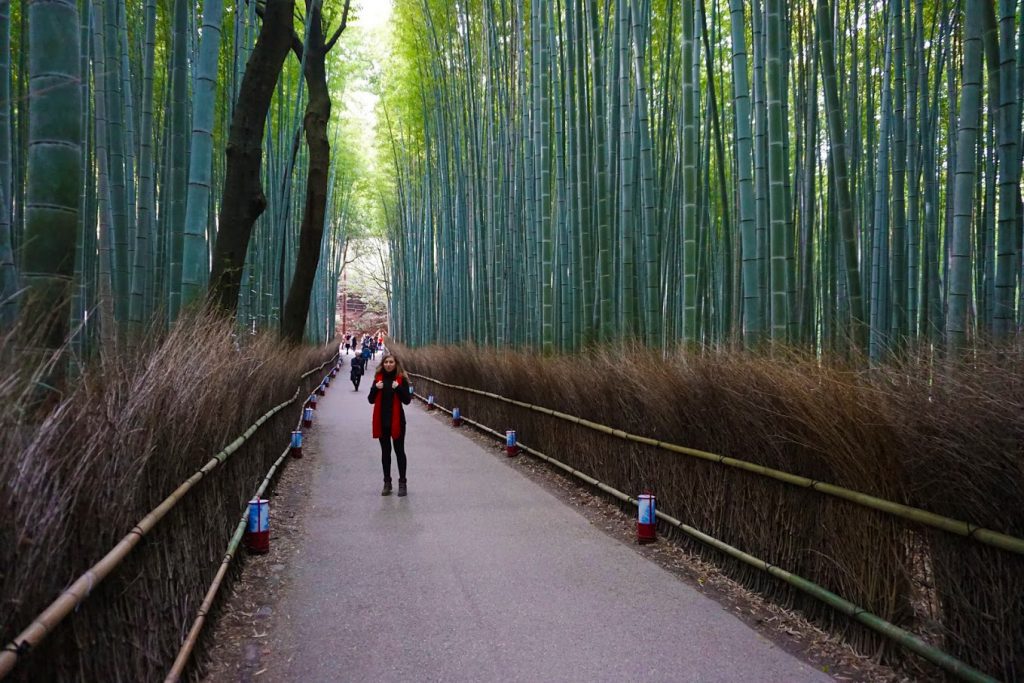
Arashiyama Bamboo Forest
Entrance Fee: Free
Opening Hours: 24/7
Next, walk through the bamboo path, which is essentially a well-defined path lined with tall and thick bamboo stalks. The bamboo forest does look special because the stalks create a natural cathedral that towers overhead. Being so tall, the leaves at the end of the stalks filter the light, casting the path in a soft, ethereal glow. If you visit in the morning, stop for a moment to listen to the way the wind sounds when it gently sways the bamboos. It’s a charming place, no wonder it attracts visitors from all over the world.
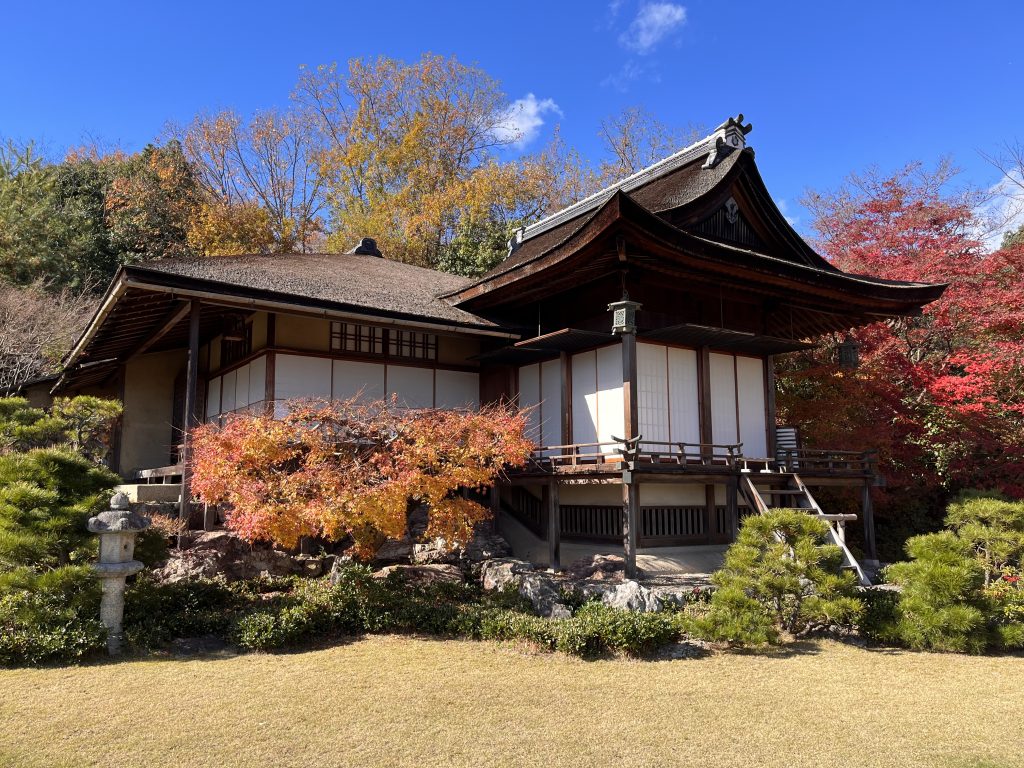
Okochi-Sanso Villa
Entrance Fee: 1000 yen
Opening Hours: 9 am–5 pm
Okochi-Sanso Villa is the original residence of the film actor Denjirō Ōkōchi and was used for several movie sets. The main attraction is its incredible garden, which has a well-defined path that takes you around the main attractions. Plus, there are areas with stunning views of the forested Arashiyama mountains and nearby residential rooftops.
The entry ticket might feel a little steep, but included in the price you get a freshly made bowl of matcha tea and a small wagashi.

Jōjakkōji Temple
Entrance Fee: 500 yen
Opening Hours: 9 am–5 pm
Jōjakkōji Temple dates back to 1596 and is located on the slopes of Mount Ogura, offering some seriously beautiful views of the surrounding mountains.
The temple features a charming pagoda, lush moss gardens, and lots of maple trees that turn vivid shades of red and orange in the autumn. You will need to climb some stone steps to be rewarded with the views, but it’s well worth your effort. Don’t tell anyone I told you, but this temple has a small bamboo grove.
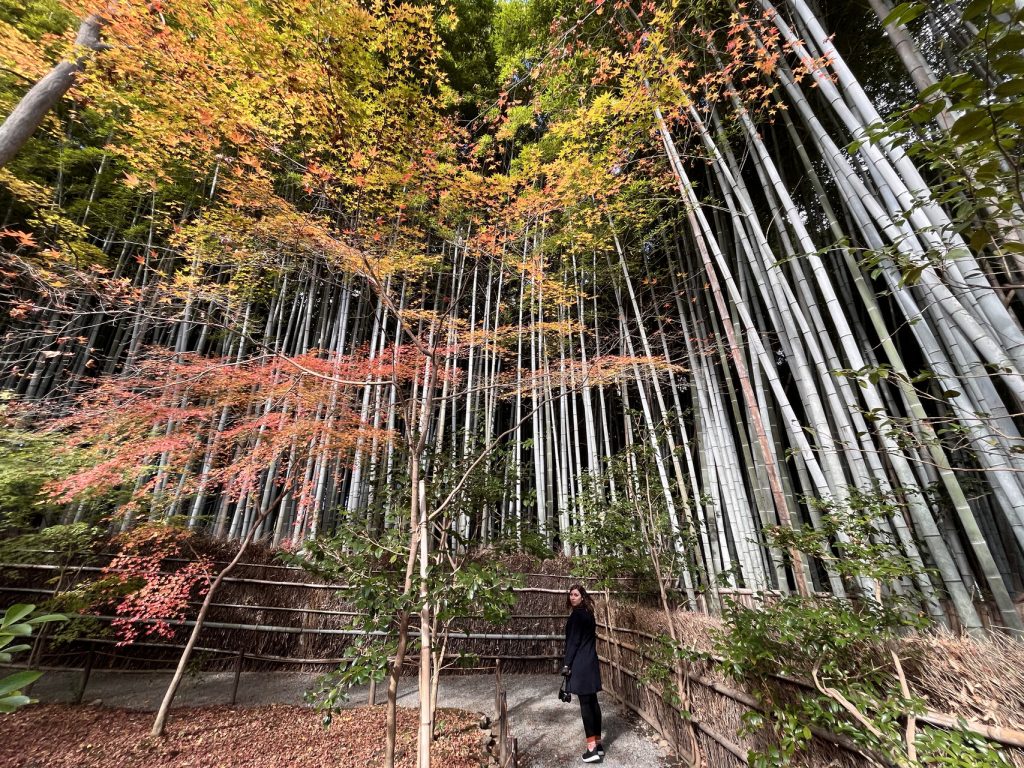
Gio-ji Temple
Entrance Fee: 300 yen
Opening Hours: 9 am–4:30 pm
Gio-ji Temple is a smaller and less known temple in Arashiyama. It’s worth a visit for its lovely moss garden, but this temple, too, has a small bamboo grove.
The temple is named after Gio, a dancer from the Heian period who became a nun after a series of unfortunate events in love. Gio-ji Temple became her residence.
Gio-ji is a much smaller temple than the previous ones, but honestly, it’s so calm and beautiful.

Saga Toriimoto Preserved Street
Entrance Fee: Free
Opening Hours: 9 am–5:00 pm (shops)
Saga Toriimoto Preserved Street is a narrow alleyway which has kept its old-world charm from the late Edo Period. It is lined with traditional wooden houses known as machiya, now transformed into small shops.
Every time we’ve come to Saga Toriimoto Preserved Street throughout the years, we had the whole street to ourselves, with barely a few other people around. It’s a great place to escape the thick crowds from the bamboo grove. There are a few souvenir shops located on this street, including Adashino Mayumura, which specialises in creating small dolls out of silk cocoons.

Lunch at Ayu-no-Yado Tsutaya
Opening Hours: 11:30 am–6:30 pm
Ayu-no-Yado Tsutaya is a kaiseki restaurant which serves set menus for lunch in a spacious room with tatami floors. There are normal tables with chairs on the tatami so you can sit comfortably and admire the garden through the large glass windows.
When I visited, they had two types of set menus for lunch only. We ordered the ayudon which is a sweet fish cooked over a bowl of rice, served with a side of miso soup and pickles. As simple as the food looked, it was so incredibly tasty and full of flavour. Note that they only took cash.
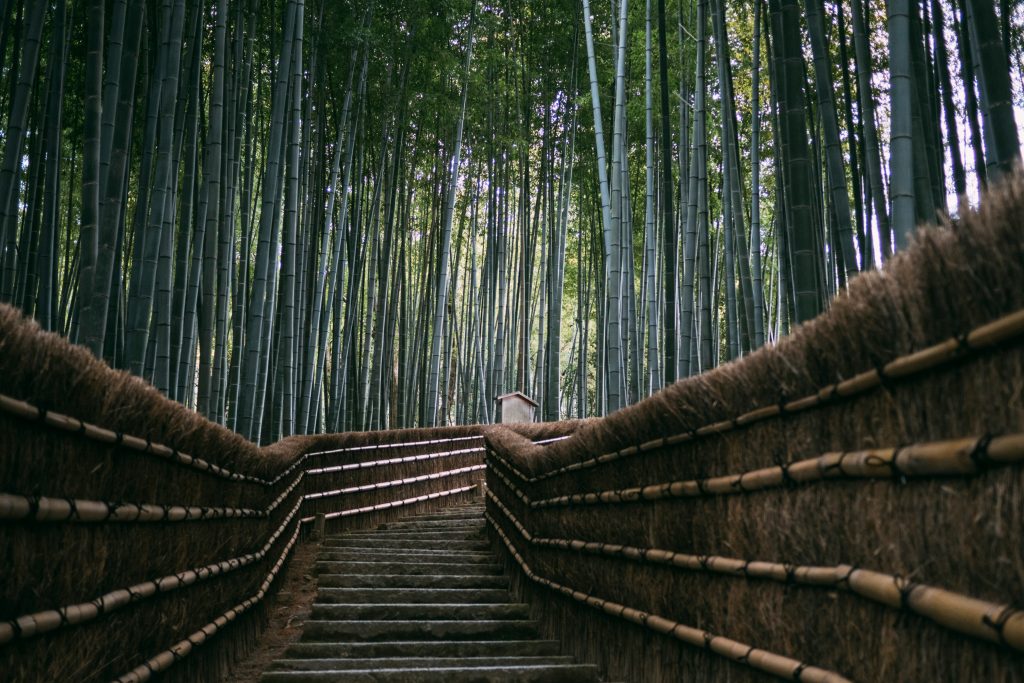
Adashino-Nembutsu-ji Temple
Entrance Fee: 500 yen
Opening Hours: 9 am–3:30 pm
Adashino-Nembutsu-ji Temple was founded in the early 9th century by the monk Kūkai, and it’s known for its 8,000 Buddhist stone statues representing the souls of the deceased. These statues have been collected from all over Kyoto and placed here over the centuries. Every year on August 23rd and 24th, the temple hosts the Sento Kuyo ceremony, where thousands of candles are lit to honor the spirits of the departed.
Adashino Nenbutsu-ji sits among tall bamboo stalks and has a lovely path with stairs that go through the bamboo, much like the famous bamboo forest in Arashiyama, but it’s quieter without all the crowds.
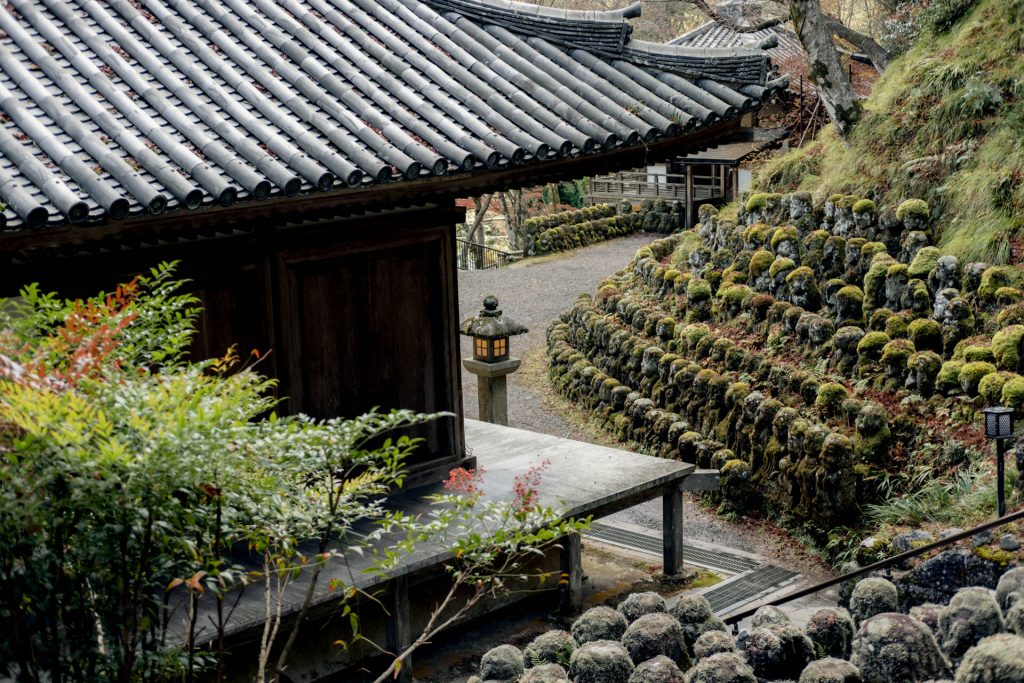
Otagi Nenbutsu-Ji
Entrance Fee: 400 yen
Opening Hours: 8 am–4:30 pm
Otagi Nenbutsu-Ji is an 8th century temple, very much off the beaten in Arashiyama, but in my opinion, one of the most striking temples. Otagi Nenbutsu-Ji is a secluded Buddhist temple, home to over 1200 rakan covered in moss. A rakan is a stone statue representing the disciples of Buddha.
All rakan statues in the Otagi Nenbutsu-Ji have been donated, and a majority have been sculpted by amateurs. It’s a fairly small temple but really beautiful and truly zen. Given that it’s a good 30-minute walk from the main Arashiyama bamboo forest, you can imagine that there are seldom any tourists here.
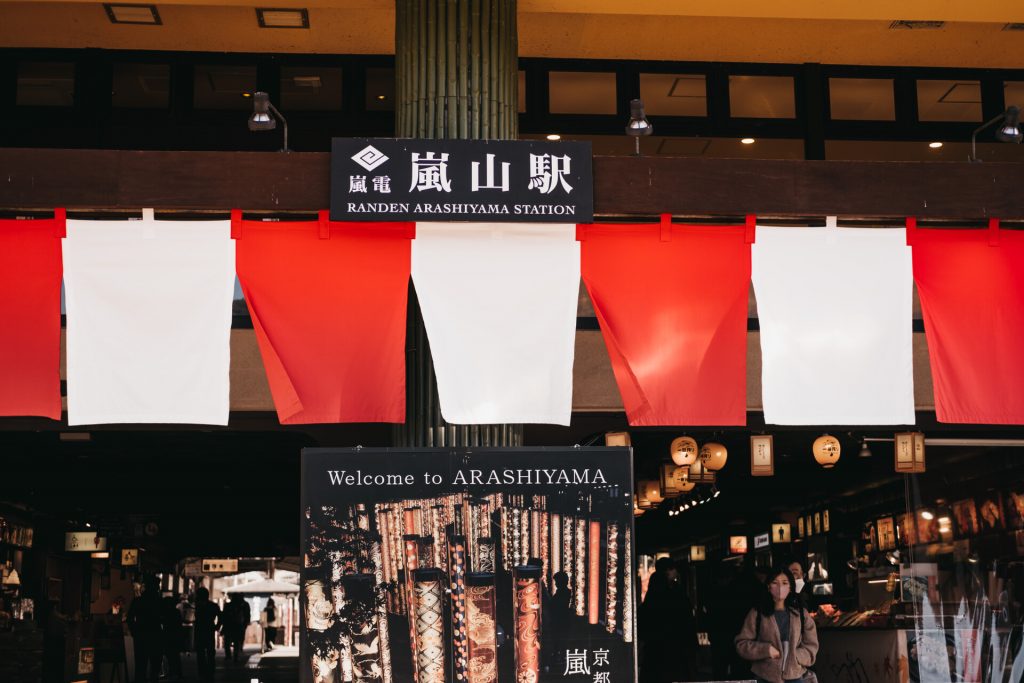
Back to the train station
Simply retrace your steps back to the train station. The trip will take about 40 minutes walk.
Alternatively, you can catch bus 62, 72, 92, or 94 from Otagidera Mae station, located right in front of Otagi Nenbutsu-Ji Temple, to the train station. The bus ride takes about 6 minutes, followed by a 7-minute walk to the train station.
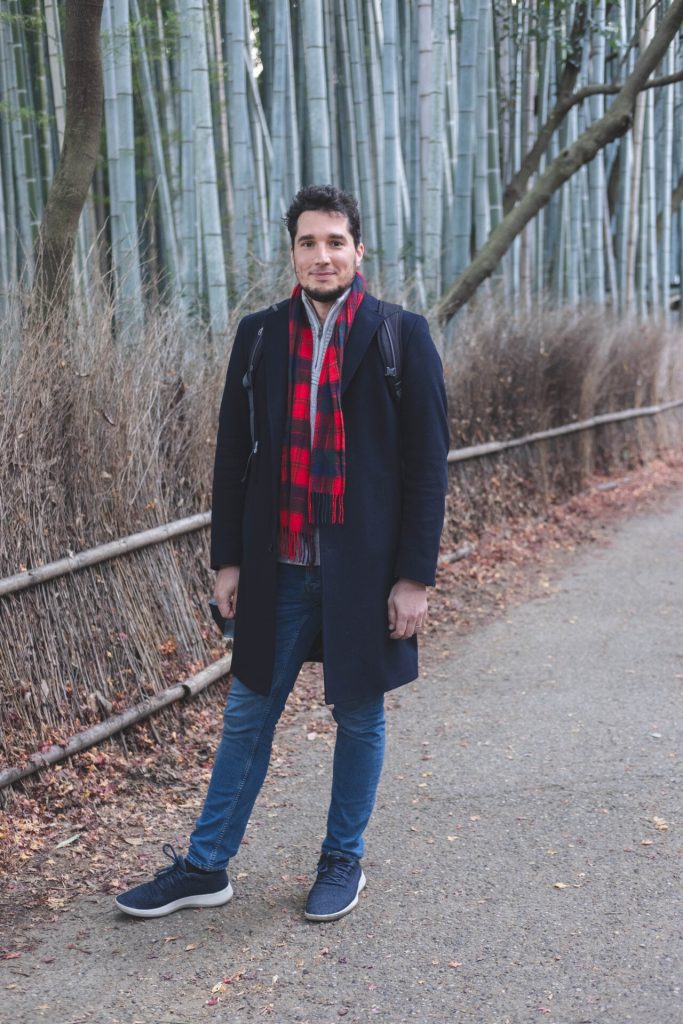
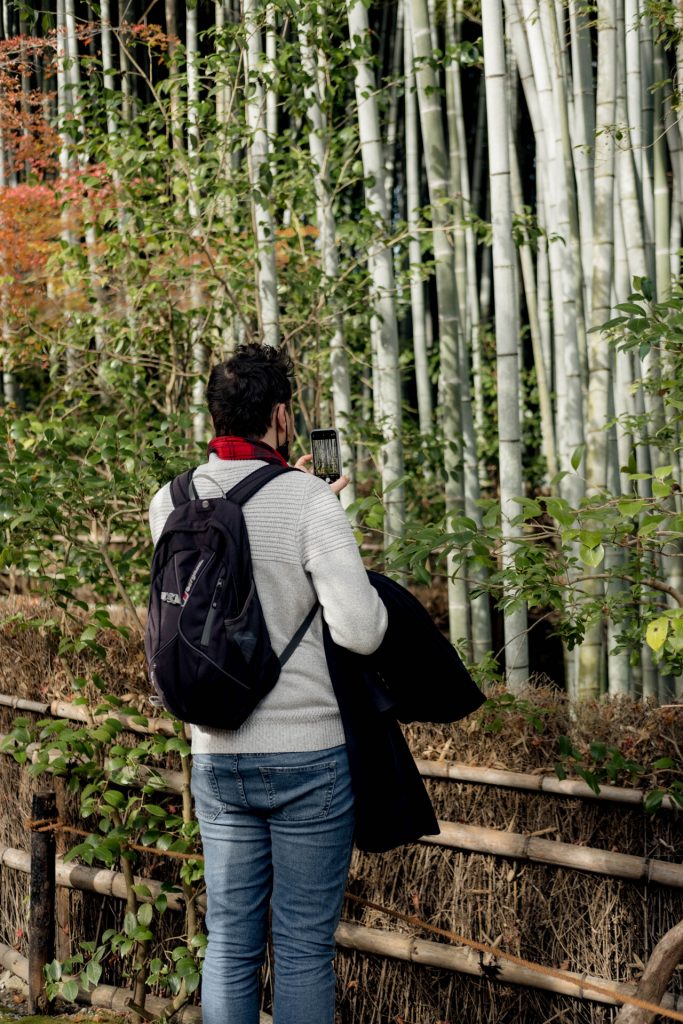
When To Photograph The Arashiyama Bamboo Grove
Personally, I think the Arashiyama Bamboo Grove is an incredibly picturesque spot perfect for photography enthusiasts. But it’s equally challenging because the bamboo grove gets some of the thickest crowds. You need to time your arrival to avoid the busiest times, so mornings are best. I’m talking about the sunrise. You want to be there at first light when the paths are quiet (with a few other photography enthusiasts).
With almost nobody around, you’ve got all the time you need to nail that perfect shot, playing around with angles and camera settings. Just after sunrise, the path lights up with a lovely, soft glow.
The bamboo forest in Arashiyama is open all hours. Given the height of the bamboo and the limited light filtering through, mastering low-light photography is a must. In my experience, you will want a wider lens for this. I tried photographing with my Fujifilm 35mm, but I changed it to a 23mm and yielded much better results.
Night visits to the bamboo grove are doable, but it gets really dark, so you’ll need to use artificial lighting or a flash. Make sure to bring some powerful flashlights for ease. In winter, there’s a chance to capture the grove after dark during the Arashiyama Hanatouro illuminations, which brighten up the paths from 5 pm to 8:30 pm. I recommend getting there around 8 pm to avoid the crowds.

Tips for Arashiyama Bamboo Grove
Arrive early – I cannot express how much nicer it is to walk around the bamboo forest without having to elbow your way through. It is a magical place to visit, but also one of the top things to do in Japan. It’s natural to expect crowds, but recently, the path has got very, very busy.
Wear comfortable shoes – To make the most out of your day in Arashiyama, you should explore the surroundings as the area is full of gardens, temples and smaller bamboo groves. Comfortable, sturdy footwear will make your visit much more enjoyable.
Respect the environment – The bamboo grove is a natural and cultural treasure. Stick to the paths, don’t leave trash behind, and avoid making loud noises. Do not touch the bamboo stalks or make any carvings in them.
Stay Nearby – To truly capture the essence of Arashiyama and visit the bamboo grove at the least crowded times, consider staying in one of the many guesthouses or hotels in the area. This allows you to beat the day-trippers to the grove and enjoy Arashiyama at a more leisurely pace.
This is a new hotel located right in the heart of Arashiyama. IT is a holiday home just about 500 m away from the Bamboo Street. You can get free bikes and can enjoy free wifi in the property. Prices start at £141 per night.
Suiran is luxurious hotel located next to Katsura River. It has a beautiful Japanese Garden and each room has a beautiful bathroom with bath and free toiletries. Guests can relax at the spa, purchase souvenirs at the gift shop, or soak in the private open-air bath with an advance reservation. Room service, 24-hour front desk and a concierge service are also available on site.
Click here for prices and book Suiran, a Luxury Collection Hotel, Kyoto
Final Thoughts
The Arashiyama bamboo grove was a surreal and wonderful experience. Let’s face it, it’s on everyone’s itinerary because it really is a natural wonder like no other in the world.
If I’m perfectly honest, Arashiyama’s beauty lies far beyond its famous bamboo grove, within the most secluded spots and lesser known temples, into the heart of the Storm Mountains. Visit the grove in the morning, and continue the day by following my walking itinerary around Arashiyama to see all the highlights and eat traditional food. You’re going to love it!





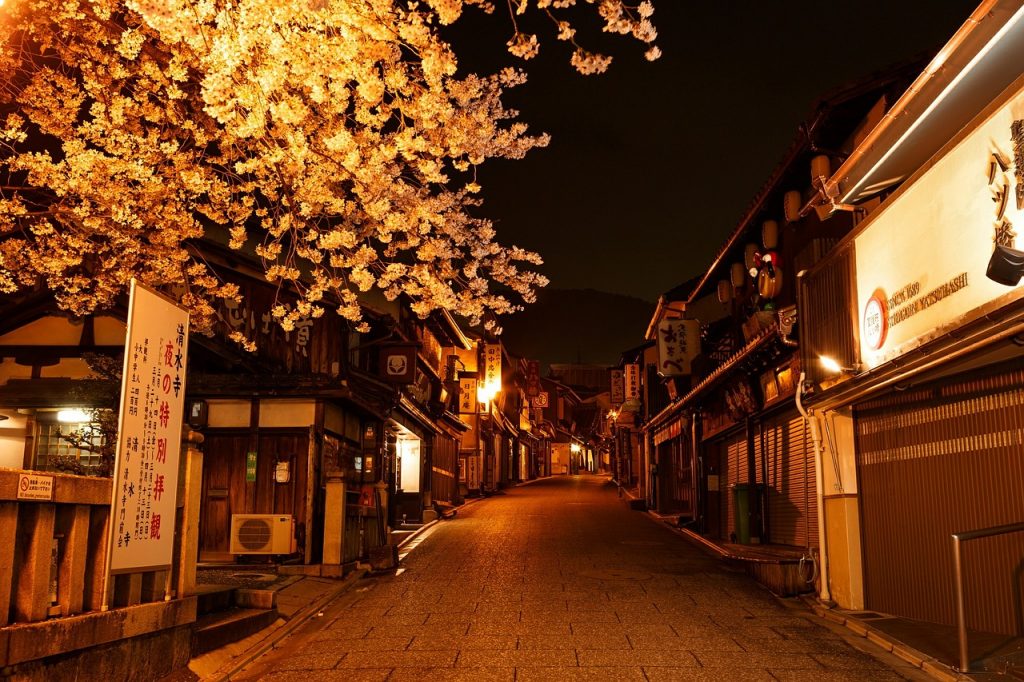
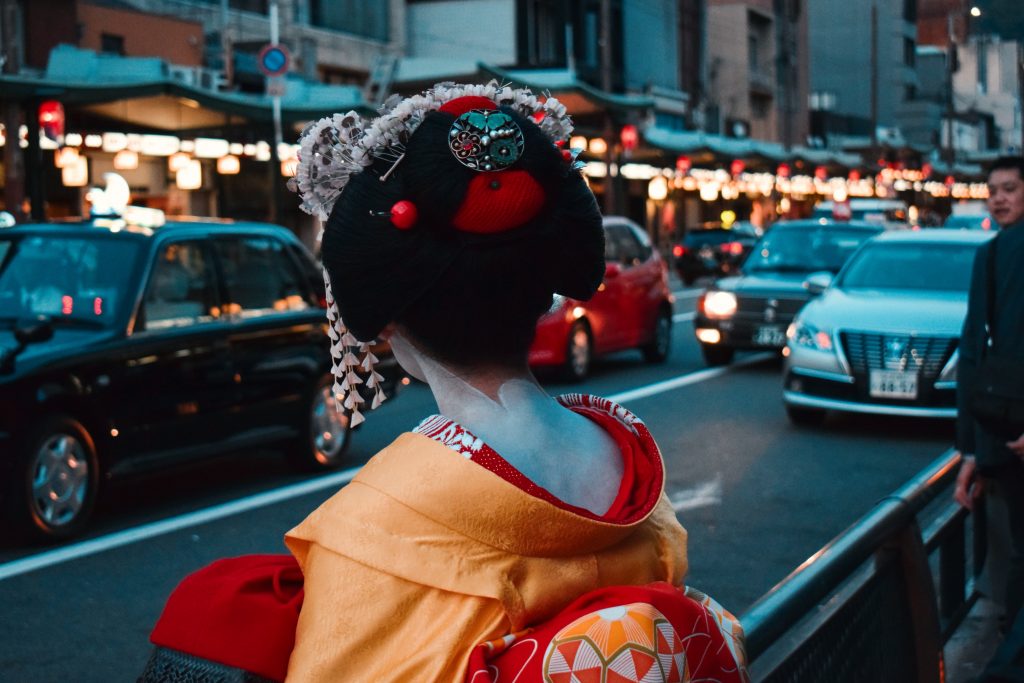



Leave a Reply